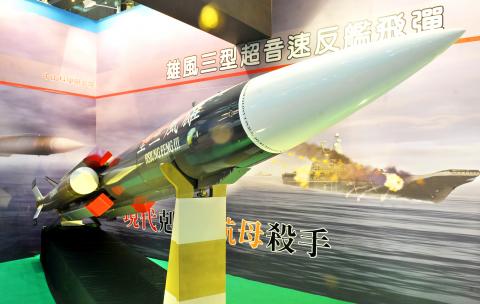In a blunt departure from tradition, the military yesterday displayed a model Hsiung Feng (“Brave Wind”) III (HF-3) anti-ship missile with, as a backdrop, a large picture of a burning aircraft carrier that bore a striking resemblance to China’s retrofitted Varyag, which embarked on its maiden voyage earlier in the day.
The booth, set at a prominent location at the Taipei Aerospace and Defense Technology Exhibition (TADTE), which opens today, was the center of attention of reporters who were given a chance to take a look around during a pre-show visit.
The HF-3, a ramjet-powered supersonic anti-ship missile, can be launched from land and surface platforms, such as Taiwan’s Perry-class frigates. The 130km-range, single-warhead missile has been in development at the Chung-Shan Institute of Science and Technology (CSIST, 中山科學研究院) since 1995. It entered production in about 2007 and is believed to have entered service the following year.

Photo: CNA
The CSIST is administered by the Ministry of National Defense’s Armaments Bureau.
Asked to confirm how many missiles were currently in production or had been deployed, Chiang Wu-ing, deputy director of the Hsiung Feng program at CSIST, would not provide figures.
While the HF-3 had been on display at previous shows, this was the first time it was shown in a context that prominently identified its intended target. Although no flag or ensign could be seen on the computer-generated rendition of the aircraft carrier and accompanying fleet, the “ski jump” ramp and general outlook were oddly similar to the Varyag China acquired from Ukraine in 1998.
Next to the burning carrier were the Chinese characters for “carrier killer,” also the first time the HF-3 had been described as such. It is doubtful, however, that the missile’s 120kg payload would be sufficient to sink an aircraft carrier.
Approached by reporters for comment on the symbolism and timing of the display, a CSIST spokesperson would not directly confirm that the vessel depicted was the Varyag.
For his part, Chiang said that when the HF-3 entered development and even after it had entered production, the Taiwanese military and CSIST could not have known that China would acquire and refurbish the Soviet-era Varyag or embark on a program to develop its own carriers, expected to enter service in about 2020.
Initial reports had said the 60,000 tonne Kuznetsov-class carrier would embark on its maiden voyage on July 1 to coincide with the 90th anniversary of the founding of the Chinese Communist Party, but unexpected developments forced a delay until this month.

People can preregister to receive their NT$10,000 (US$325) cash distributed from the central government on Nov. 5 after President William Lai (賴清德) yesterday signed the Special Budget for Strengthening Economic, Social and National Security Resilience, the Executive Yuan told a news conference last night. The special budget, passed by the Legislative Yuan on Friday last week with a cash handout budget of NT$236 billion, was officially submitted to the Executive Yuan and the Presidential Office yesterday afternoon. People can register through the official Web site at https://10000.gov.tw to have the funds deposited into their bank accounts, withdraw the funds at automated teller

PEACE AND STABILITY: Maintaining the cross-strait ‘status quo’ has long been the government’s position, the Ministry of Foreign Affairs said Taiwan is committed to maintaining the cross-strait “status quo” and seeks no escalation of tensions, the Ministry of Foreign Affairs (MOFA) said yesterday, rebutting a Time magazine opinion piece that described President William Lai (賴清德) as a “reckless leader.” The article, titled “The US Must Beware of Taiwan’s Reckless Leader,” was written by Lyle Goldstein, director of the Asia Program at the Washington-based Defense Priorities think tank. Goldstein wrote that Taiwan is “the world’s most dangerous flashpoint” amid ongoing conflicts in the Middle East and Russia’s invasion of Ukraine. He said that the situation in the Taiwan Strait has become less stable

CONCESSION: A Shin Kong official said that the firm was ‘willing to contribute’ to the nation, as the move would enable Nvidia Crop to build its headquarters in Taiwan Shin Kong Life Insurance Co (新光人壽) yesterday said it would relinquish land-use rights, or known as surface rights, for two plots in Taipei’s Beitou District (北投), paving the way for Nvidia Corp to expand its office footprint in Taiwan. The insurer said it made the decision “in the interest of the nation’s greater good” and would not seek compensation from taxpayers for potential future losses, calling the move a gesture to resolve a months-long impasse among the insurer, the Taipei City Government and the US chip giant. “The decision was made on the condition that the Taipei City Government reimburses the related

FRESH LOOK: A committee would gather expert and public input on the themes and visual motifs that would appear on the notes, the central bank governor said The central bank has launched a comprehensive redesign of New Taiwan dollar banknotes to enhance anti-counterfeiting measures, improve accessibility and align the bills with global sustainability standards, Governor Yang Chin-long (楊金龍) told a meeting of the legislature’s Finance Committee yesterday. The overhaul would affect all five denominations — NT$100, NT$200, NT$500, NT$1,000 and NT$2,000 notes — but not coins, Yang said. It would be the first major update to the banknotes in 24 years, as the current series, introduced in 2001, has remained in circulation amid rapid advances in printing technology and security standards. “Updating the notes is essential to safeguard the integrity